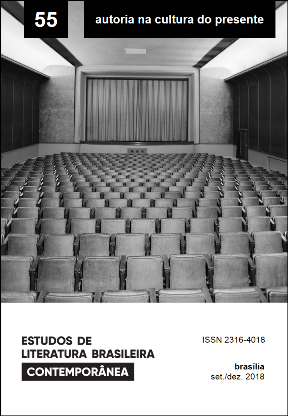The oblique witness in O que os cegos estão sonhando?, by Noemi Jaffe, and Maus, by Art Spiegelman
DOI:
https://doi.org/10.1590/10.1590/2316-40185515Abstract
This article develops a comparative analysis of the works, O que os cegos estão sonhando?, by Noemi Jaffe, and Maus, by Art Spiegelman. The critical examination discusses some similarities in the process of how authorship is constructed in these two books. Particularly, the essay discusses the self-representation of the children of Nazi concentration camps survivors, and the manner in which second generation narratives take the form of an oblique witness, which constitute, at the same time prolongation and rupture with the testimonies of surviving parents.
Downloads
References
AGAMBEN, Giorgio (2014). O que resta de Auschwitz. Tradução de Selvino J. Assmann. São Paulo: Boitempo.
BERGER, Alan; BERGER, Naomi (Org.) (2001). Second generation voices: reflections by children of holocaust survivors perpetrators. New York: Syracuse University Press.
CURI, Fabiano Andrade (2009). Maus, de Art Spiegelman: uma outra história da Shoah. Síntesis, Campinas, v. 14, p. 140-158.
FUX, Jacques (2013a). Até quando os cegos continuarão sonhando? Revista de Letras, Fortaleza, v. 2, n. 32, p. 47-52, ago./dez.
FUX, Jacques (2013b). W ou o testemunho da infância. Letras de Hoje, Porto Alegre, v. 48, p. 459-466.
GAGNEBIN, Jeanne Marie (2014). Lembrar escrever esquecer. São Paulo: Editora 34.
HIRSCH, Marianne (2008). The generation of postmemory. Poetics Today, Durham, v. 29, n. 1, p. 103-128.
JAFFE, Noemi (2012). O que os cegos estão sonhando? ”“ Com diário de Lili Jaffe (1944-1945) e texto final de Leda Cartum. São Paulo: Editora 34.
LEVI, Primo (1990). Os afogados e os sobreviventes. Tradução de Luiz Sérgio Henriques. Rio de Janeiro: Paz e Terra.
MARCO, Valéria de (2004). A literatura de testemunho e a violência de estado. Revista Lua Nova, n. 62, p. 45-68.
NASCIMENTO, Larissa Silva (2012). Para além das cercas de arame farpado: o Holocausto em Maus, de Art Spiegelman, e em Os emigrantes, de W. G. Sebald. Dissertação (Mestrado em Literatura e Práticas Sociais) ”“ Universidade de Brasília, Brasília.
PARISOTE, Amanda Dal’Zotto (2016). Entre autoras, diários e memórias: a linguagem da barbárie em O que os cegos estão sonhando? Revista do Instituto Cultural Judaico Marc Chagall, São Paulo, v. 8, n. 1, jan./jun.
SELIGMANN-SILVA, Márcio (Org.) (2013). História, memória, literatura: o testemunho na Era das Catástrofes. São Paulo: Editora da Unicamp.
SPIEGELMAN, Art (2016). Maus. Tradução de Antonio de Macedo Soares. São Paulo: Cia. Das Letras.
WIESEL, Elie (1987). Holocausto: canto de uma geração perdida. Tradução de Roberto Raposo. São Paulo: Documentário.
Published
How to Cite
Issue
Section
License
Authors who publish in this journal agree to the following terms:
a) The authors maintain the copyright and grant the journal the right of first publication, the work being simultaneously licensed under the Creative Commons Attribution License-Non Commercial 4.0 which allows the sharing of the work with acknowledgment of the authorship of the work and publication this journal.
b) Authors are authorized to enter into additional contracts separately, for non-exclusive distribution of the version of the work published in this journal (eg publish in institutional repository or as a book chapter), with authorship recognition and publication in this journal.
c) Authors are allowed and encouraged to publish and distribute their work online (eg in institutional repositories or on their personal page) after the editorial process, as this can generate productive changes, as well as increase the impact and citation of published work (See The Effect of Free Access).
d) The authors of the approved works authorize the magazine to, after publication, transfer its content for reproduction in content crawlers, virtual libraries and the like.
e) The authors assume that the texts submitted to the publication are of their original creation, being fully responsible for their content in the event of possible opposition by third parties.


